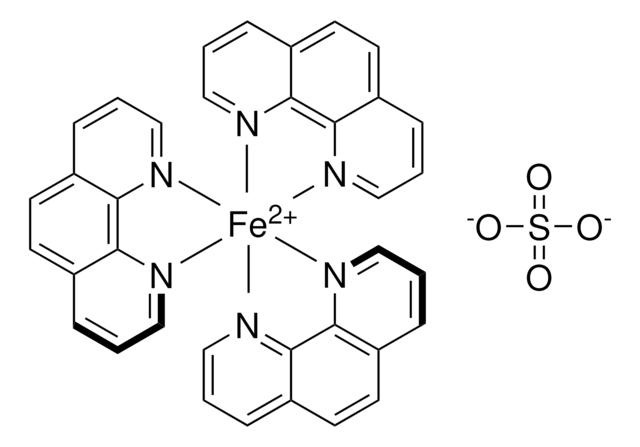229547
Ammonium cerium(IV) nitrate
≥99.99% trace metals basis
Synonym(s):
Ceric ammonium nitrate
About This Item
Recommended Products
Quality Level
Assay
≥99.99% trace metals basis
form
crystalline
reaction suitability
reagent type: oxidant
impurities
≤100.0 ppm Trace Metal Analysis
SMILES string
N.N.[Ce+4].O[N+]([O-])=O.O[N+]([O-])=O.[O-][N+]([O-])=O.[O-][N+]([O-])=O.[O-][N+]([O-])=O.[O-][N+]([O-])=O
InChI
1S/Ce.2HNO3.4NO3.2H3N/c;6*2-1(3)4;;/h;2*(H,2,3,4);;;;;2*1H3/q+4;;;4*-1;;
InChI key
WIBGOERAEYJBOT-UHFFFAOYSA-N
Looking for similar products? Visit Product Comparison Guide
Application
Signal Word
Danger
Hazard Statements
Precautionary Statements
Hazard Classifications
Acute Tox. 4 Oral - Aquatic Acute 1 - Aquatic Chronic 1 - Eye Dam. 1 - Met. Corr. 1 - Ox. Sol. 2 - Skin Corr. 1B - Skin Sens. 1A
Storage Class Code
5.1B - Oxidizing hazardous materials
WGK
WGK 3
Personal Protective Equipment
Choose from one of the most recent versions:
Already Own This Product?
Find documentation for the products that you have recently purchased in the Document Library.
Customers Also Viewed
Articles
Oxidation and reduction reactions are some of the most common transformations encountered in organic synthesis, and are some of the organic chemist’s most powerful tools for creating novel products. Below is a list of the most commonly used oxidizing and reducing agents currently available in our catalog.
The rare earth elements impact nearly everyone in the world. All of the people living in advanced technological countries and almost all those living in third world countries utilize the rare earths in their everyday living—the car that one drives (gasoline is refined from oil using rare earth catalysts and catalytic converters reduce the polluting emissions from the automotive exhaust), watching the news on TV (the red and green colors in TV screens), the telephones and computers we use to communicate (the permanent magnets in speakers and disc drives), just to name a few examples.
Our team of scientists has experience in all areas of research including Life Science, Material Science, Chemical Synthesis, Chromatography, Analytical and many others.
Contact Technical Service




